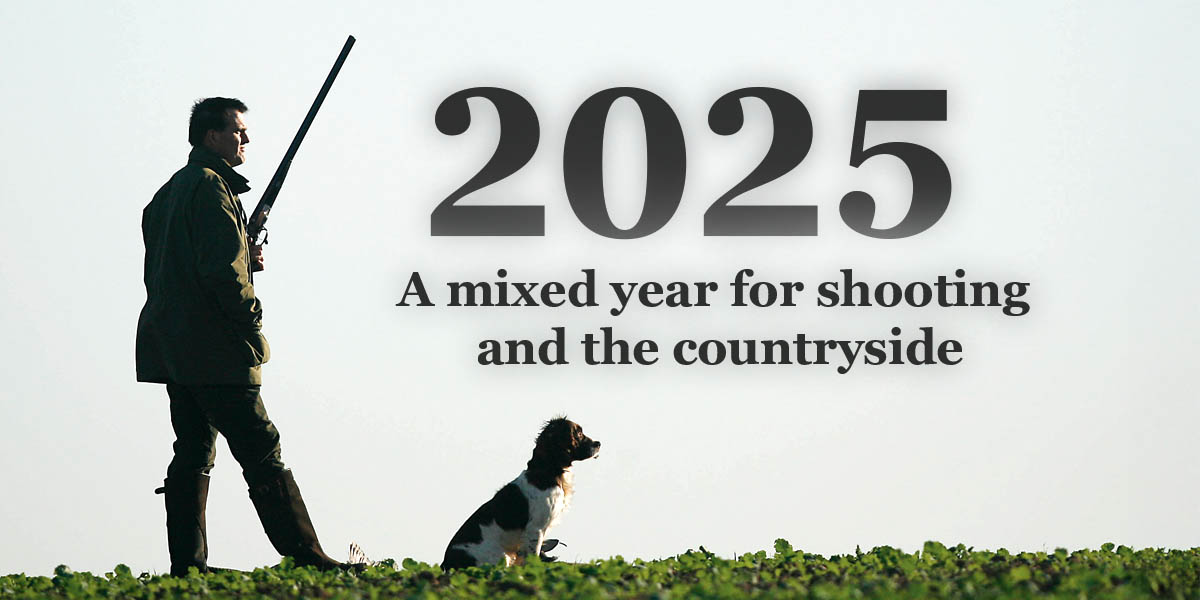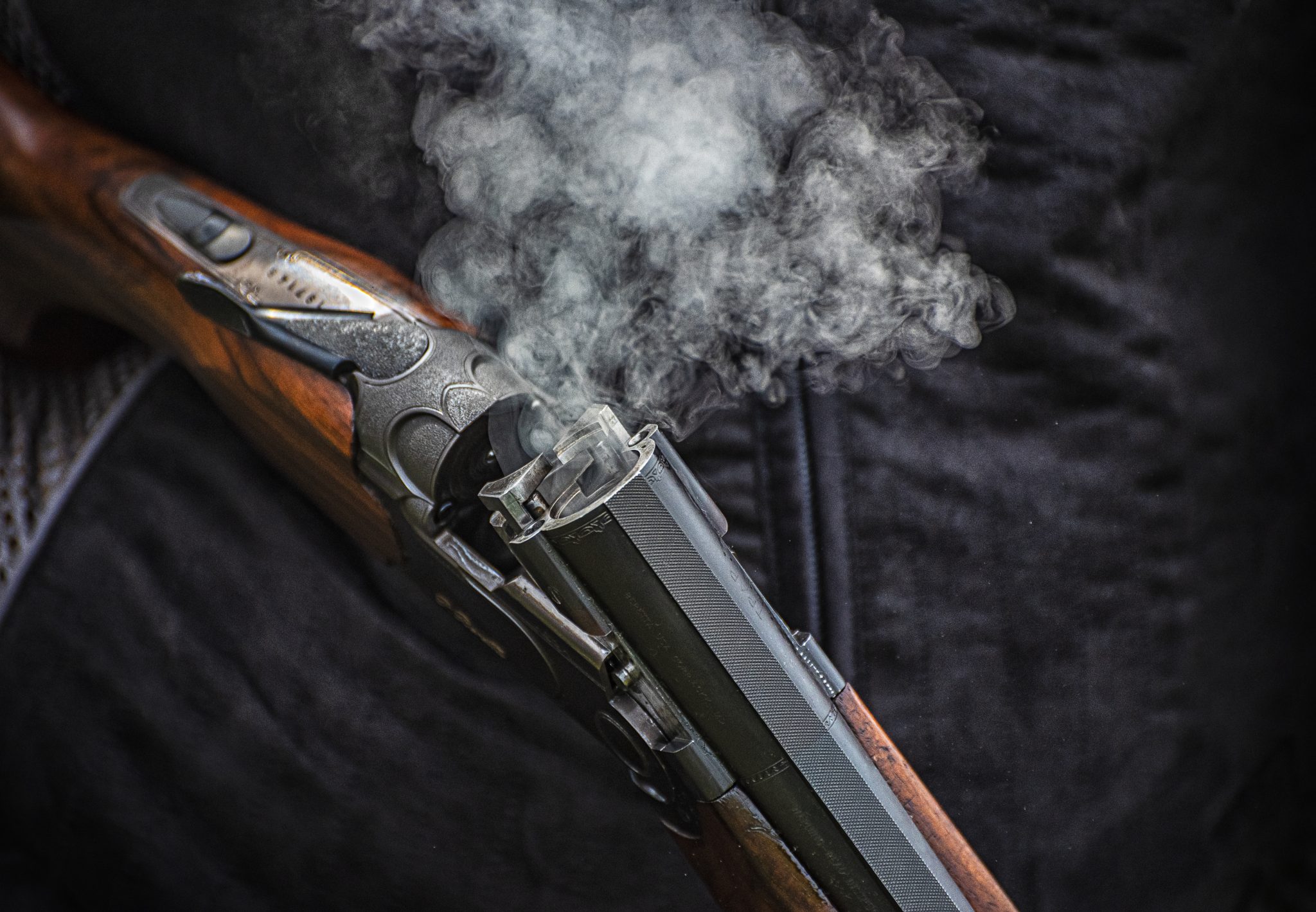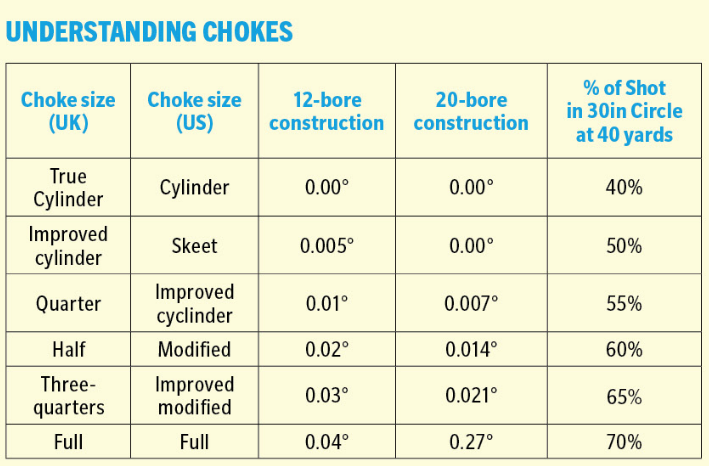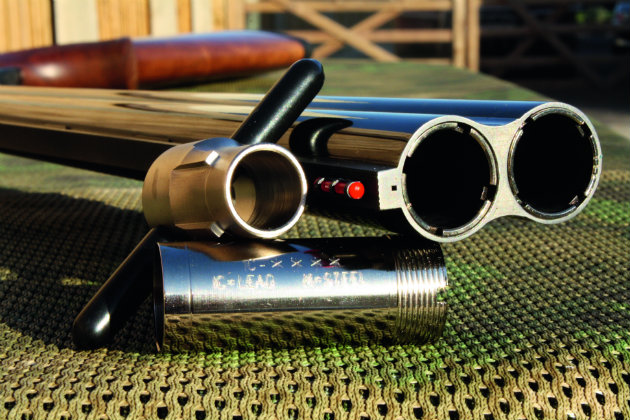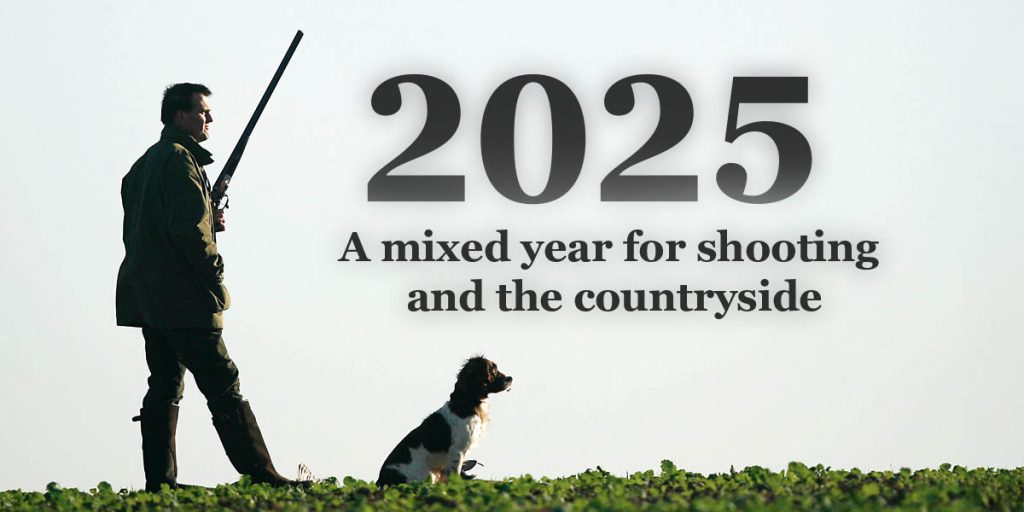Win CENS ProFlex DX5 earplugs worth £1,149 – enter here
Shotgun choke – here’s what you need to know about it
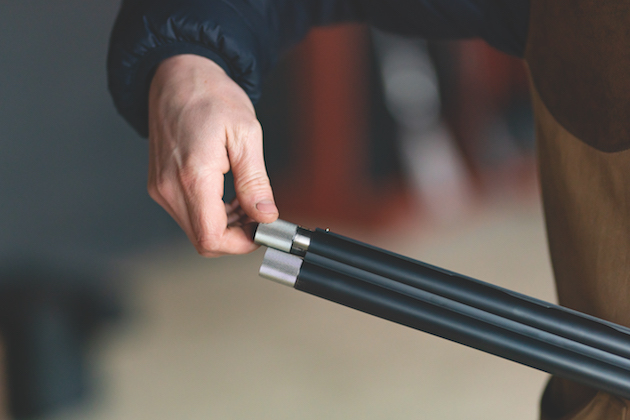 Fitting a choke
Usd 27 march 19 chokes
Fitting a choke
Usd 27 march 19 chokes
Shotgun choke does as it sounds. Chokes. That is, it constricts or narrows the barrels of a shotgun. This has the effect of reducing the pattern so that the density of the pellets is increased, which gives a stronger result. Visualise shotgun choke in the same way as a camera aperture which opens or reduces to give more or less light. So how does this help gameshooters and clayshooters?
Open shotgun choke vs closed
The more open chokes are, the larger the diameter of the shot cloud or pattern. The tighter the shotgun choke, the smaller the pattern. Chokes won’t magically improve your shooting and probably won’t help you hit the target more often. However open chokes can be good for closer targets and the standard quarter & half choke (more on this later) is a good place to start. Having very tight chokes, particularly full or extra full, and squeezing heavy loads of large shot through them will often result in deformed pellets that do not fly true.
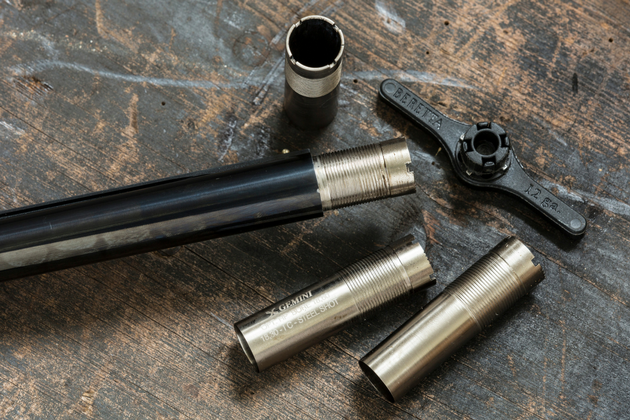
Frantically changing chokes rarely helps matters
What’s better – fixed or screw in chokes?
Most of us don’t shoot well enough to get any real benefit from chokes. So opt for fixed chokes or ones that are very open. However if you are a very good shot then screw-in chokes may help.
The first wave of screw-in chokes appeared in the late 1970s with the Winchester 101 series of guns. Since then, multi-chokes have been very popular, both as factory standard and as custom attachments from specialist makers.
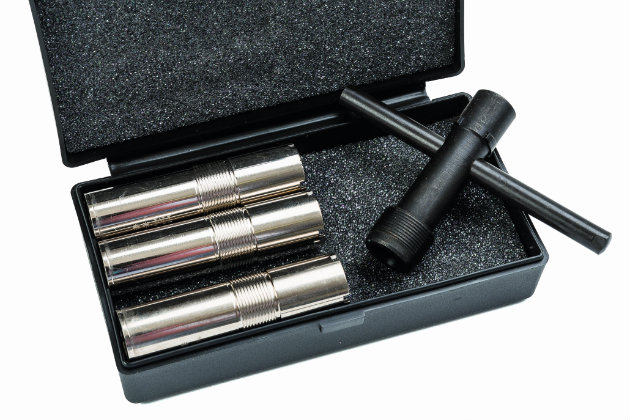
If your gun has multi-chokes, ensure they are tightly screwed in
Multi-chokes offer tremendous versatility without the need to own a number of shotguns, but they need to be looked after if they are to remain trouble-free. Always pay close attention to the manufacturer’s instructions for the maintenance of multi-chokes. Multi-chokes sit in a section of the muzzle that has been specially machined to receive them. It is vitally important to ensure that they are screwed fully home so that there is no gap between the inside of the barrel and the base of the choke section. If even the tiniest gap exists, there is a very real possibility that serious damage will occur to the gun.
As a general principle, multi-chokes should have their threaded sections very lightly greased with something similar to Vaseline before they are screwed home. Beware of over-tightening, and if you are unfortunate enough to get a choke stuck, do not force it but take it to a gunsmith for “surgical” removal.
Looking after your chokes
Check that your chokes are screwed home fully before use and repeat this check after and periodically during use. Chokes should be cleaned occasionally by immersion in petrol or a similar solvent. Pay particular attention to the threads and make sure that foreign bodies such as grit are removed before installing the chokes again. Always discard a damaged shotgun choke tube.
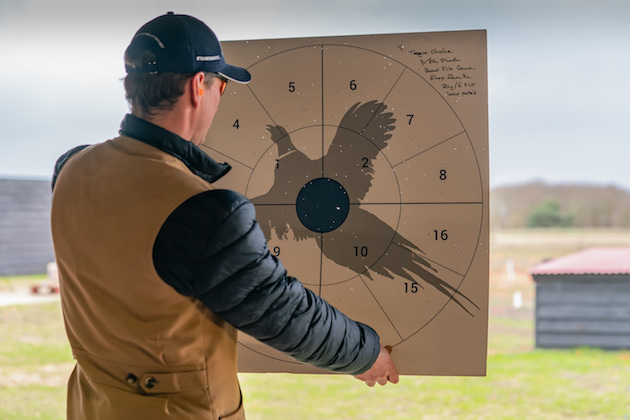
It is vital to use a pattern plate to determine what combination of choke works for you
Choosing the right shotgun choke combination
The smaller the shot size, the more pellets there are to the ounce: No. 4 shot is 135 to the ounce, No.5 is 170, No.6 is 225 and No. 7.5 is 350. It follows, therefore, that if you reduce the number of pellets in a cartridge, the pattern density will also be reduced and there will be more “holes” in it. The only way to increase pattern density is to tighten up the choke, which is not good for the average 20-yard shot, or increase the weight of shot in a cartridge, which generates more felt (perceived) recoil.
Choke is a constriction of a few thousandths of an inch in the last two or three inches of a barrel. On a 12-bore, full choke is a constriction of 40 thousandths of an inch, half-choke 20 thousandths of an inch, quarter-choke 10 thousandths of an inch and improved choke around five thousandths of an inch. The effect of choke is to squeeze the shot column as it is leaving the barrel and control the rate of spread.
Using a fibre or plastic wad will also affect the pattern density. Generally, a plastic wad will give a tighter pattern than a fibre wad. As conscientious, environmentally-concerned shooters, we should avoid using plastic wads however.
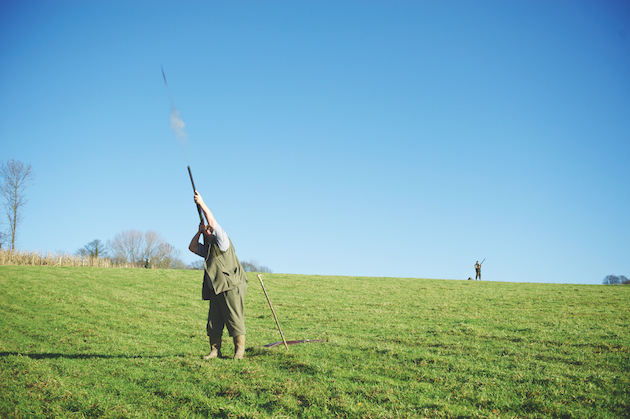
Good stance, gun fit and technique are as important as the right chokes
Chokes for clays and different quarry
- Small, light birds, such as woodcock or snipe, do not need as much striking energy as a high cock pheasant to kill them, but being a smaller target, it makes sense to use smaller shot sizes and increase pattern density, giving us the greater chance of a good hit. An ounce of shot or 11/16oz will be plenty, generating modest recoil.
- Pheasants, pigeon and duck have a greater body weight and require more penetration and kinetic energy, so shot sizes No. 5 or No. 6 will deliver what is required. To maintain pattern density, we could increase the weight of shot to 11/8oz. The weight of the gun has a bearing here — in a light side-by-side 11/8oz will generate considerable felt recoil; 11⁄4oz will be very uncomfortable. In a heavier over-and-under, delivering the recoil in a straighter line lower into the shoulder, there will be much less perception of recoil. Geese and the highest pheasants will demand heavier, larger pellets to carry sufficient striking energy, penetration and shock to the target. Now we need 11⁄4oz or 36g to maintain pattern quality. You will need a heavy gun to soak up the recoil of these loads, and full-choke is not usually the most appropriate option.
A side-by-side generally has the more open choke in the right barrel/front trigger. This dates back to the days of muzzle-loaders, when game was walked- up over pointers. The first shot at a departing target would be the closer shot. With the advent of breechloaders and driven shooting, this remains unchanged, yet the first shot should be further away and the second directly overhead. The same applies on flighted pigeon or duck and geese overhead. You can select which barrel/choke to use on a shot by judicious use of the triggers on a double-trigger gun or the selector on others.
I’ve never been able to make up my mind on what’s the right amount of choke to have in a gun. Tight guns bring certain advantages when shooting any of the five trap disciplines, but how much — or how little — is best for a gun used in the field, or on a sporting clay range?
The quarter/half approach probably is the best middle-of- the-road solution for most people’s needs.
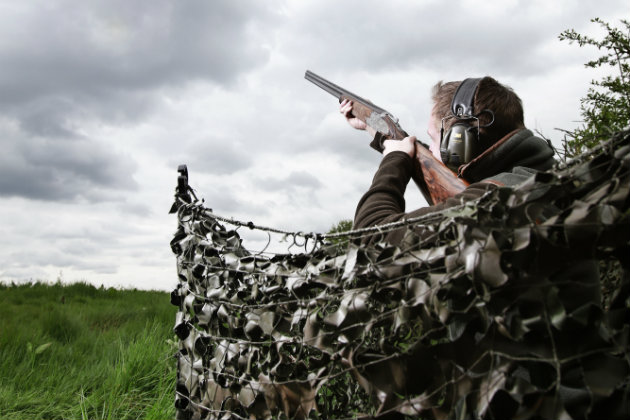
Interchangeable chokes mean that we can now use one gun for most disciplines
More choke?
Former Browning (UK) managing director Andrew Young and his gunsmith used to cringe at the sight of my 125’s bare chequering, wonky extractors and worn chambers whenever I used it in their company. I bought the 30in gun new about 25 years ago with, you’ve guessed, quarter and half-choke barrels. It was, and still is, a nice enough gun to shoot.
But it held a secret that I didn’t pick up on for about 10 years or so. Not once did I suspect anything was untoward. Why would I? The gun killed the highest of pheasants clean as a whistle, as well as everything else from geese on the foreshore to snipe, clays and woodpigeon over decoys or coming to roost. Then I thought: “Maybe if I had more choke I might pick up a few extra clays in competitions? So off it went to a lad in Suffolk who specialised in fitting “invisible” internal choke tubes. My instruction was to make four: full, three- quarters, heavy half (about 22 thou) and true half (20 thou). Three weeks later, I went to his workshop to collect the gun.
“Robin, what chokes do you think you’ve been using all this time?” he asked. So I told him quarter and half as supplied by the factory. “Best think again,” he said.
It turned out that the bottom barrel, when he took the micrometer to it, measured a gnat’s whisker over true cylinder and the top, improved cylinder. I was mystified.
“It seems to me that these tubes started off at 32in but, for some reason or other, they were cut down in the factory,” he said.
“They actually measure a little less than 30in and if you look, whoever refitted the foresight bead didn’t even get it central to the rib.” True enough, it was off-centre by about 2mm.
I would like to say the expensive conversion brought about the improvement I had hoped. However, fitting the gun with much tighter chokes didn’t make an iota of difference — instead, my Sporting average actually dipped!
Tall pheasants and chokes
It’s been my pleasure to watch more than a few competent game Shots kill very tall pheasants cleanly and consistently with small shot and open chokes. Best — in more ways than one — was an elderly gentleman knocking down high birds and making it look so easy with standard Eley Grand Prix No.6s and an English side-by-side with only improved cylinder out in front. If you do have a multi-choke gun in the cabinet, screw-in cylinder and quarter, use a decent cartridge, and see how you fare.
Shotgun choke names
Choke denominations used in the UK are usually expressed as:
- True cylinder
- Improved
- Quarter
- Half
- Three quarter
- Full
In the USA those terms are usually described as:
- Cylinder
- Skeet
- Improved cylinder
- Modified
- Improved modified
- Full
Shotgun choke tips summary
- If you swap chokes around you can use the same shotgun for a variety of different disciplines.
- Most of us don’t shoot well enough to get any real benefit from choke.
- Screw-in chokes arrived in the late 1970s with the Winchester 101 series of guns.
- Good technique and practice are the secrets of good marksmanship. Not chokes.
- Almost every Gun will suffer from a bout of choke changing-itis.
- Frantic choke changing rarely helps accuracy.
- Novice shooters should forget excessive choke and concentrate on ensuring that patterns are adequate at 40 yards and not over-tight.
- Look at the patterns to see what choke works best in your gun.
- Tight patterns may give clean kills at long range but at short distances they demand more accuracy.
- Quarter and quarter or half and half is a good choke for pigeon shooting.
- Chokes should be cleaned now and then by dipping in petrol.
- If the choke is hard to remove, a few drops of releasing fluid may help to break the seal. Allow it to penetrate and then warm the muzzles with a hairdryer which will make the barrels expand, allowing the choke tube to be withdrawn.
- If a choke is still stuck, don’t force it. Take it to a gunsmith for removal.
- Be careful when you apply pressure to the choke tubes, as it is very easy to distort the barrel.
- Don’t keep damaged chokes, throw them away.
- Ensure that your chokes are screwed home fully before using.
- Check chokes are free of grit and other foreign bodies.
- The threaded section of multi-chokes should be lightly greased with Vaseline or its equivalent before being screwed home.
- Do not overtighten chokes
- On a sporting layout with a lot of closer targets try Skeet & Skeet or quarter & quarter
- Trap disciplines are best shot using tighter chokes, typically three quarters and full
- Multi-chokes sit in a section of the muzzle that has been specially machined to receive them.
- Multi-chokes need to be cared for to remain trouble-free.
- Multi-chokes must be screwed in sufficiently so no gap remains between the inside of the barrel and the base of the choke section.
- If a tiny gap does remain serious damage may occur to the gun- this is called “choke pick-up”
- Multi-chokes have become very popular, both as factory standard and as custom attachments from specialist makers.
- Always wipe choke tubes clean of old lubricant. A toothbrush dipped in meths is ideal for cleaning the tube and barrel threads. Dry well after cleaning.
Related Articles
Get the latest news delivered direct to your door
Subscribe to Shooting Times & Country
Discover the ultimate companion for field sports enthusiasts with Shooting Times & Country Magazine, the UK’s leading weekly publication that has been at the forefront of shooting culture since 1882. Subscribers gain access to expert tips, comprehensive gear reviews, seasonal advice and a vibrant community of like-minded shooters.
Save on shop price when you subscribe with weekly issues featuring in-depth articles on gundog training, exclusive member offers and access to the digital back issue library. A Shooting Times & Country subscription is more than a magazine, don’t just read about the countryside; immerse yourself in its most authoritative and engaging publication.




